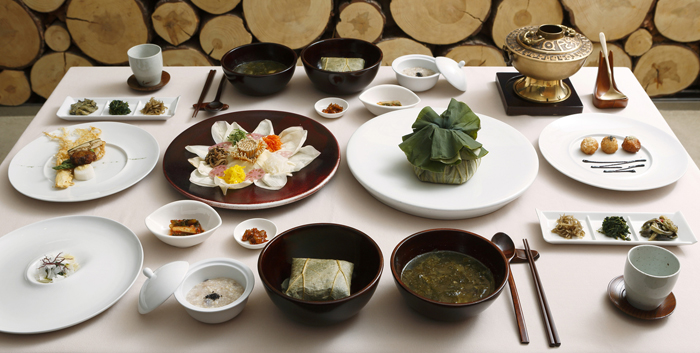Not many moons ago, a close friend and I, both vegetarian, went to a Korean restaurant for its famous honey-butter chips. We left the table hungrier than when we went in. Turns out the chips were the only vegetarian dish the Manhattan establishment offered besides a teensy tofu starter.
With the Korean barbecue in the foreground and well-known Korean-American chefs (think David Chang and Danny Bowien) emphasizing meat-heavy fare, it’d be understandable if you assumed Korean cuisine wasn’t exactly vegan- or vegetarian-friendly. But you’d quickly find out otherwise if you ate just once at an actual temple on the hills of South Korea, any of the Seoul restaurants where the tradition is continued (such as famous Sanchon), or niche Korean temple cuisine restaurants like New York City’s Hangawi.
Made according to Buddhist traditions, Korean temple cuisine is free of meat, fish, dairy, garlic, and onions of any kind. The tradition goes as far back as the fourth century, when the Jinkwansa temple outside Seoul was first founded. There’s a holistic, Buddhist philosophy behind the food: You become what you eat, and what you eat—at least in the temple residents’ case—surrounds you. The ingredients must be foraged from around the temple grounds, so, the nuns (and monks) who cook the meals are often involved with the gardening as well. Meaning what’s being served at the temples has always been seasonal and sustainable. Other “trending” methods that were recently rediscovered among Portland/Brooklyn circles include fermenting, dehydrating, and pickling. A nun’s usual lunch or dinner consists of three or four banchans (side dishes) with rice, but when dining at a restaurant or with bigger groups, you could order more. Layers of flavor, in large part, come from the pickled and fermented items, which can be stewing for north of fifty years.
Tucked between Midtown and the Garment District is New York’s only temple cuisine restaurant. Hangawi is surprisingly old: The restaurant first opened its doors in 1994 and has only gotten better. The calm, meditative dining room is always full of patrons, and a 2016 mention in the Michelin Guide proves that the menu has no problem staying current. Hangawi is also deeply rooted in tradition, and continues to offer more classic temple dishes like todok (stone bowl rice), deodoka (a variant of bonnet bellflower, widely used in temple cuisine), wild mountain roots and greens, and tofu kimchi hot pot. More modern and even non-Korean interests are incorporated, too—kale, avocado, and quinoa make ample appearances on the menu.
As Europe and America rekindled with naturalism in cooking by the way of Rene Redzepi’s Noma, and David Kinch’s Manresa, Korean temple food did have a crossover moment with world-renowned chefs: Just as David Chang was opening Má Pêche, Food & Wine asked the meat-obsessed chef to visit two Korean temples to see how vegetarianism would sit with him (it ended up going well!) And as late as last winter, Le Bernardin chef Eric Ripert invited Jeong Kwan, a Zen Buddhist nun at Baekyangsa temple to his private dining room in New York to cook lunch for a small group of guests. Kwan is considered one of the best chefs in the world, which Ripert, in part, credits to the stress-free nature of monastic life and lack of time constraints.
We may not all be lucky enough to get fed by a Buddhist nun celebrity chef in our lifetime, but at least you know what to Google now. What you seek is seeking you.














